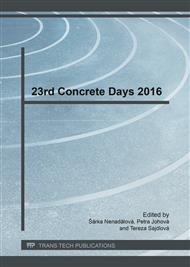p.75
p.80
p.85
p.90
p.97
p.101
p.106
p.113
p.119
Low-Strength Self-Compacting Concrete
Abstract:
Self-compacting concretes (SCC) are relatively modern building material that has great potential for using in a wide range of applications. Its origin and development is considered a major breakthrough in concrete technology, especially because of its ease of placement without the need to use external dynamic forces in the form of vibrations. This can significantly affect the resulting properties of concrete as well as working conditions on the building site.To maintain the fresh concrete’s rheological properties and, at the same time, achieve lower final strength, reduced amount of Portland cement needs to be proposed in mixture design. Then, to keep the number of fine particles at high level, it is necessary to use fine grained cement compatible additives which do not chemically participate on hydration process – at least not too much – and thus do not increase the resulting strength.This paper will address the verification of inert additives functionality for the production of lower-strength self-compacting concretes, namely in strength classes C16/20 and C25/30 according to ČSN EN 206. The inert admixture used in this experiment – stone dust from Zelesice quarry – has a relatively high water absorption. Therefore, the particularly crucial part was the fine-tuning of fresh SCC’s rheological properties. The results are clearly pointing to the possibility of lower-strength self-compacting concretes’ production and thus makes it possible to expand the usability portfolio of this type of modern construction material with regard to its lower production costs.
Info:
Periodical:
Pages:
97-100
Citation:
Online since:
May 2017
Authors:
Keywords:
Price:
Сopyright:
© 2017 Trans Tech Publications Ltd. All Rights Reserved
Share:
Citation:


